英国中古时期 (1)
- 格式:ppt
- 大小:1.46 MB
- 文档页数:33
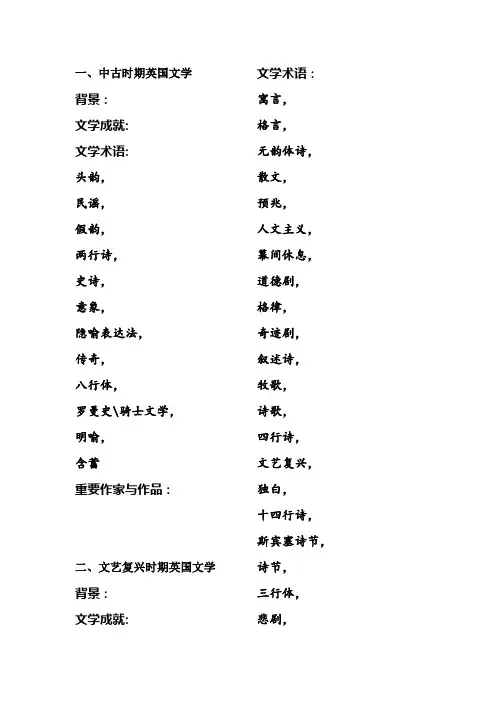
一、中古时期英国文学背景:文学成就:文学术语:头韵,民谣,假韵,两行诗,史诗,意象,隐喻表达法,传奇,八行体,罗曼史\骑士文学,明喻,含蓄重要作家与作品:二、文艺复兴时期英国文学背景:文学成就: 文学术语:寓言,格言,无韵体诗,散文,预兆,人文主义,幕间休息,道德剧,格律,奇迹剧,叙述诗,牧歌,诗歌,四行诗,文艺复兴,独白,十四行诗,斯宾塞诗节,诗节,三行体,悲剧,扬抑格,大学才子重要作家与作品:三、17世纪资产阶级革命和王朝复辟时期背景:文学成就:文学术语:押韵,及时行乐,教诲文学,挽歌,体裁,暗喻,玄学派诗歌,奇想重要作家与作品:四、18世纪英国启蒙运动背景:文学成就:文学术语:旁白,古典主义运动,启蒙运动,结局,书言体小说,闹剧,小说,哥特小说,墓地派诗歌,讽刺史诗,新古典主义,小说(novel),前浪漫主义,叠句,讽刺,意象主义,主题重要作家与作品:五、浪漫主义时期的英国文学背景:文学成就:文学术语:拜伦式英雄,篇、章,寓言,湖湖畔派诗人,抒情诗,颂歌,浪漫主义重要作家与作品:六、维多利亚时期英国批判现实主义文学背景:文学成就:文学术语:暗喻|典故,反面人物,角色,批判现实主义,戏剧独白,倒叙,旁白,陈述者,心理小说,叙述角度,情节,正面人物重要作家与作品:七、20世纪英国文学背景:文学成就:文学术语:唯美主义,黑色幽默,达达主义,顿悟,自由间接引语,现代主义,俄狄甫斯情节,戏谑模仿作品,意识流,超现实主义,荒诞派戏剧,口吻,愤怒的青年重要作家与作品:八、当代英国文学背景:文学成就:文学术语:实验小说,半开放结局,元小说,运动派,极端现实主义戏剧重要作家与作品:一、殖民地时期及独立革命时期的美国文学背景:文学成就:文学术语:美国清教主义,自传重要作家与作品:二、浪漫主义时期的美国文学背景:文学成就:文学术语:美国浪漫主义,美国超验主义,加尔文主义,自由体诗歌,新英格兰诗人,象征,象征主义重要作家与作品:三、现实主义时期的美国文学背景:文学成就:文学术语:美国自然主义,美国现实主义,达尔文主义,地方主义重要作家与作品:四、20世纪美国文学背景:文学成就:文学术语:垮掉的一代,宿命论,表现主义,弗洛伊德学派,哈莱姆文艺复兴,海明威式英雄,印象派,印象主义,爵士乐时代,迷失的一代,新批评派,南方文艺复兴,荒原派作家,约克纳帕塔式重要作家与作品:五、当代美国文学背景:文学成就:文学术语:后现代主义,自白诗,黑山派诗人,重要作家与作品:。
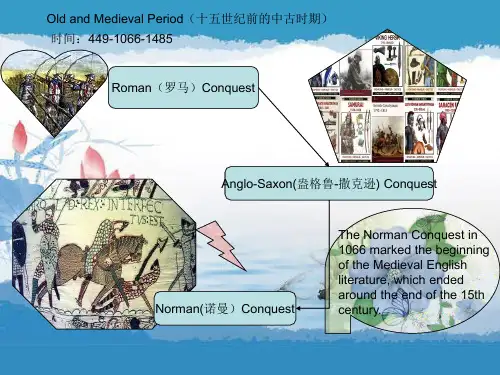
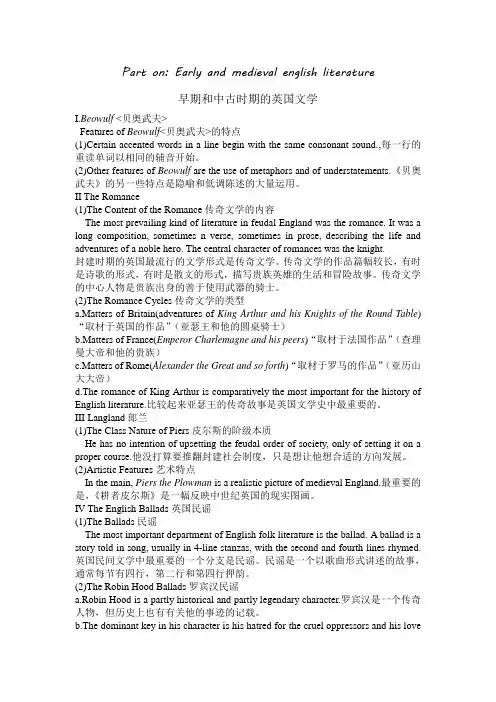
Part on: Early and medieval english literature早期和中古时期的英国文学I.Beowulf <贝奥武夫>Features of Beowulf<贝奥武夫>的特点(1)Certain accented words in a line begin with the same consonant sound.,每一行的重读单词以相同的辅音开始。
(2)Other features of Beowulf are the use of metaphors and of understatements.《贝奥武夫》的另一些特点是隐喻和低调陈述的大量运用。
II The Romance(1)The Content of the Romance传奇文学的内容The most prevailing kind of literature in feudal England was the romance. It was a long composition, sometimes n verse, sometimes in prose, describing the life and adventures of a noble hero. The central character of romances was the knight.封建时期的英国最流行的文学形式是传奇文学。
传奇文学的作品篇幅较长,有时是诗歌的形式,有时是散文的形式,描写贵族英雄的生活和冒险故事。
传奇文学的中心人物是贵族出身的善于使用武器的骑士。
(2)The Romance Cycles传奇文学的类型a.Matters of Britain(adventures of King Arthur and his Knights of the Round Table)“取材于英国的作品”(亚瑟王和他的圆桌骑士)b.Matters of France(Emperor Charlemagne and his peers)“取材于法国作品”(查理曼大帝和他的贵族)c.Matters of Rome(Alexander the Great and so forth)“取材于罗马的作品”(亚历山大大帝)d.The romance of King Arthur is comparatively the most important for the history of English literature.比较起来亚瑟王的传奇故事是英国文学史中最重要的。
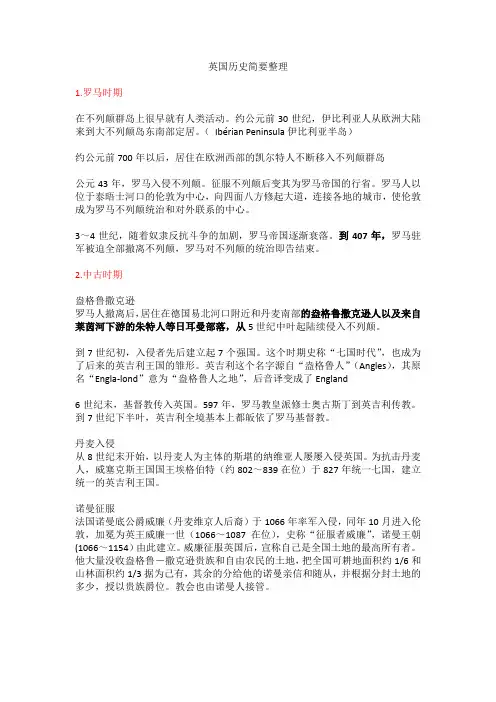
英国历史简要整理1.罗马时期在不列颠群岛上很早就有人类活动。
约公元前30世纪,伊比利亚人从欧洲大陆来到大不列颠岛东南部定居。
(Ibérian Peninsula伊比利亚半岛)约公元前700年以后,居住在欧洲西部的凯尔特人不断移入不列颠群岛公元43年,罗马入侵不列颠。
征服不列颠后变其为罗马帝国的行省。
罗马人以位于泰晤士河口的伦敦为中心,向四面八方修起大道,连接各地的城市,使伦敦成为罗马不列颠统治和对外联系的中心。
3~4世纪,随着奴隶反抗斗争的加剧,罗马帝国逐渐衰落。
到407年,罗马驻军被迫全部撤离不列颠,罗马对不列颠的统治即告结束。
2.中古时期盎格鲁撒克逊罗马人撤离后,居住在德国易北河口附近和丹麦南部的盎格鲁撒克逊人以及来自莱茵河下游的朱特人等日耳曼部落,从5世纪中叶起陆续侵入不列颠。
到7世纪初,入侵者先后建立起7个强国。
这个时期史称“七国时代”,也成为了后来的英吉利王国的雏形。
英吉利这个名字源自“盎格鲁人”(Angles),其原名“Engla-lond”意为“盎格鲁人之地”,后音译变成了England6世纪末,基督教传入英国。
597年,罗马教皇派修士奥古斯丁到英吉利传教。
到7世纪下半叶,英吉利全境基本上都皈依了罗马基督教。
丹麦入侵从8世纪末开始,以丹麦人为主体的斯堪的纳维亚人屡屡入侵英国。
为抗击丹麦人,威塞克斯王国国王埃格伯特(约802~839在位)于827年统一七国,建立统一的英吉利王国。
诺曼征服法国诺曼底公爵威廉(丹麦维京人后裔)于1066年率军入侵,同年10月进入伦敦,加冕为英王威廉一世(1066~1087在位),史称“征服者威廉”,诺曼王朝(1066~1154)由此建立。
威廉征服英国后,宣称自己是全国土地的最高所有者。
他大量没收盎格鲁-撒克逊贵族和自由农民的土地,把全国可耕地面积约1/6和山林面积约1/3据为己有,其余的分给他的诺曼亲信和随从,并根据分封土地的多少,授以贵族爵位。
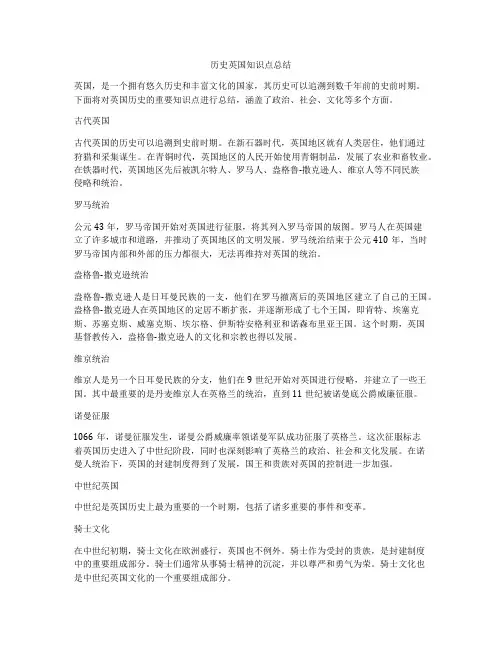
历史英国知识点总结英国,是一个拥有悠久历史和丰富文化的国家,其历史可以追溯到数千年前的史前时期。
下面将对英国历史的重要知识点进行总结,涵盖了政治、社会、文化等多个方面。
古代英国古代英国的历史可以追溯到史前时期。
在新石器时代,英国地区就有人类居住,他们通过狩猎和采集谋生。
在青铜时代,英国地区的人民开始使用青铜制品,发展了农业和畜牧业。
在铁器时代,英国地区先后被凯尔特人、罗马人、盎格鲁-撒克逊人、维京人等不同民族侵略和统治。
罗马统治公元43年,罗马帝国开始对英国进行征服,将其列入罗马帝国的版图。
罗马人在英国建立了许多城市和道路,并推动了英国地区的文明发展。
罗马统治结束于公元410年,当时罗马帝国内部和外部的压力都很大,无法再维持对英国的统治。
盎格鲁-撒克逊统治盎格鲁-撒克逊人是日耳曼民族的一支,他们在罗马撤离后的英国地区建立了自己的王国。
盎格鲁-撒克逊人在英国地区的定居不断扩张,并逐渐形成了七个王国,即肯特、埃塞克斯、苏塞克斯、威塞克斯、埃尔格、伊斯特安格利亚和诺森布里亚王国。
这个时期,英国基督教传入,盎格鲁-撒克逊人的文化和宗教也得以发展。
维京统治维京人是另一个日耳曼民族的分支,他们在9世纪开始对英国进行侵略,并建立了一些王国。
其中最重要的是丹麦维京人在英格兰的统治,直到11世纪被诺曼底公爵威廉征服。
诺曼征服1066年,诺曼征服发生,诺曼公爵威廉率领诺曼军队成功征服了英格兰。
这次征服标志着英国历史进入了中世纪阶段,同时也深刻影响了英格兰的政治、社会和文化发展。
在诺曼人统治下,英国的封建制度得到了发展,国王和贵族对英国的控制进一步加强。
中世纪英国中世纪是英国历史上最为重要的一个时期,包括了诸多重要的事件和变革。
骑士文化在中世纪初期,骑士文化在欧洲盛行,英国也不例外。
骑士作为受封的贵族,是封建制度中的重要组成部分。
骑士们通常从事骑士精神的沉淀,并以尊严和勇气为荣。
骑士文化也是中世纪英国文化的一个重要组成部分。
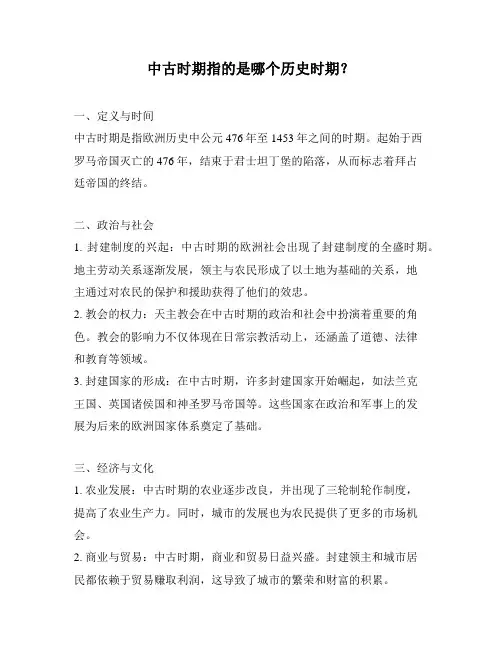
中古时期指的是哪个历史时期?一、定义与时间中古时期是指欧洲历史中公元476年至1453年之间的时期。
起始于西罗马帝国灭亡的476年,结束于君士坦丁堡的陷落,从而标志着拜占廷帝国的终结。
二、政治与社会1. 封建制度的兴起:中古时期的欧洲社会出现了封建制度的全盛时期。
地主劳动关系逐渐发展,领主与农民形成了以土地为基础的关系,地主通过对农民的保护和援助获得了他们的效忠。
2. 教会的权力:天主教会在中古时期的政治和社会中扮演着重要的角色。
教会的影响力不仅体现在日常宗教活动上,还涵盖了道德、法律和教育等领域。
3. 封建国家的形成:在中古时期,许多封建国家开始崛起,如法兰克王国、英国诸侯国和神圣罗马帝国等。
这些国家在政治和军事上的发展为后来的欧洲国家体系奠定了基础。
三、经济与文化1. 农业发展:中古时期的农业逐步改良,并出现了三轮制轮作制度,提高了农业生产力。
同时,城市的发展也为农民提供了更多的市场机会。
2. 商业与贸易:中古时期,商业和贸易日益兴盛。
封建领主和城市居民都依赖于贸易赚取利润,这导致了城市的繁荣和财富的积累。
3. 文化与知识传播:在中古时期,修道院成为了知识和学术的重要中心。
修道院内的学者翻译了许多经典著作,促进了文化和学术的传播。
4. 文艺复兴前夜:中古时期的结束被认为是文艺复兴的前夜。
文艺复兴时期对古希腊和古罗马文化的重新发现和赞美,使欧洲逐渐脱离了中世纪的束缚。
总结:中古时期是欧洲历史上一个重要的时期,标志着罗马帝国的衰落和复兴时期的雏形。
在政治、社会、经济和文化等各个方面,中古时期都有着明显的特点和发展趋势。
了解中古时期的历史,可以帮助我们更好地理解欧洲历史的发展脉络以及当前社会的一些问题。
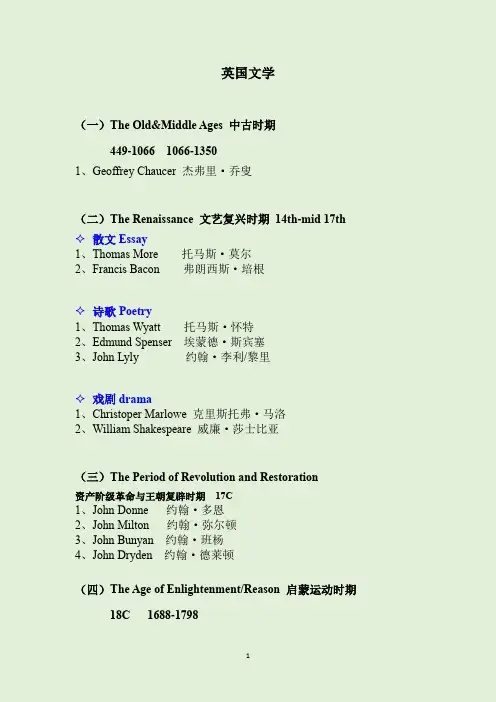
英国文学(一)The Old&Middle Ages 中古时期449-1066 1066-13501、Geoffrey Chaucer 杰弗里·乔叟(二)The Renaissance 文艺复兴时期14th-mid 17th✧散文Essay1、Thomas More 托马斯·莫尔2、Francis Bacon 弗朗西斯·培根✧诗歌Poetry1、Thomas Wyatt 托马斯·怀特2、Edmund Spenser 埃蒙德·斯宾塞3、John Lyly 约翰·李利/黎里✧戏剧drama1、Christoper Marlowe 克里斯托弗·马洛2、William Shakespeare 威廉·莎士比亚(三)The Period of Revolution and Restoration资产阶级革命与王朝复辟时期17C1、John Donne 约翰·多恩2、John Milton 约翰·弥尔顿3、John Bunyan 约翰·班杨4、John Dryden 约翰·德莱顿(四)The Age of Enlightenment/Reason 启蒙运动时期18C 1688-17981、Daniel Defoe 丹尼尔·笛福2、Jonathan Swift 乔纳森·斯威夫特3、Henry Fielding 亨利·菲尔丁4、Richard Brinsley Sheridan 理查德·谢里丹5、Joseph Addison 约瑟夫·爱迪生6、Richard Steele 理查德·斯蒂尔(五)The Romantic Period 浪漫主义时期1798-1832✧诗歌Poetry1、William Blake 威廉·布莱克2、Robert Burns 罗伯特·彭斯3、William Wordsworth 威廉·华兹华斯✧小说Novel1、Jane Austin 简·奥斯汀2、Walter Scott 沃尔特·司各特(六)The Victorian Age 维多利亚时期1832-19021、Charles Dickens 查尔斯·狄更斯2、William Makepeace Thackeray 威廉·梅克比斯·萨克雷3、George Eliot 乔治·艾略特4、The Bronte Sisters 勃朗特三姐妹5、Alfred Tennyson 阿尔弗雷德·丁尼生6、Robert Browning 罗伯特·勃朗宁7、Elizabeth Barrett Browning 伊丽莎白·巴雷特·勃朗宁8、Mathew Arnold 马修·阿诺德(七)The 20th Century 二十世纪1、Thomas Hardy 托马斯·哈代2、John Galsworthy 约翰・高尔斯华绥3、Oscar Wilde 奥斯卡·王尔德4、wrence 大卫·赫伯特·劳伦斯5、Virginia Wolf 弗吉尼亚·伍尔夫6、Joseph Conrad 约瑟夫·康拉德7、James Joyce 詹姆斯·乔伊斯8、George Bernard Shaw 乔治·萧伯纳9、E.M.Forster 爱德华·摩根·福斯特10、William Golding 威廉·戈尔丁。
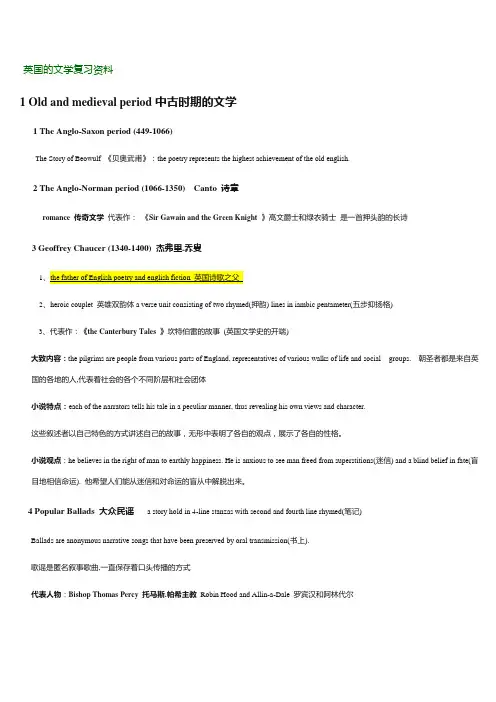
英国的文学复习资料1 Old and medieval period中古时期的文学1 The Anglo-Saxon period (449-1066)The Story of Beowulf 《贝奥武甫》:the poetry represents the highest achievement of the old english.2 The Anglo-Norman period (1066-1350) Canto 诗章romance 传奇文学代表作:《Sir Gawain and the Green Knight》高文爵士和绿衣骑士是一首押头韵的长诗3 Geoffrey Chaucer (1340-1400) 杰弗里.乔叟12、heroic couplet 英雄双韵体a verse unit consisting of two rhymed(押韵) lines in iambic pentameter(五步抑扬格)3、代表作:《the Canterbury Tales 》坎特伯雷的故事(英国文学史的开端)大致内容:the pilgrims are people from various parts of England, representatives of various walks of life and social groups. 朝圣者都是来自英国的各地的人,代表着社会的各个不同阶层和社会团体小说特点:each of the narrators tells his tale in a peculiar manner, thus revealing his own views and character.这些叙述者以自己特色的方式讲述自己的故事,无形中表明了各自的观点,展示了各自的性格。
小说观点:he believes in the right of man to earthly happiness. He is anxious to see man freed from superstitions(迷信) and a blind belief in fate(盲目地相信命运). 他希望人们能从迷信和对命运的盲从中解脱出来。

英国历史年代简要整理英国历史简要整理1.罗马时期在不列颠群岛上很早就有人类活动。
约公元前30世纪,伊比利亚人从欧洲大陆来到大不列颠岛东南部定居。
(Ibérian Peninsula伊比利亚半岛)约公元前700年以后,居住在欧洲西部的凯尔特人不断移入不列颠群岛公元43年,罗马入侵不列颠。
征服不列颠后变其为罗马帝国的行省。
罗马人以位于泰晤士河口的伦敦为中心,向四面八方修起大道,连接各地的城市,使伦敦成为罗马不列颠统治和对外联系的中心。
3~4世纪,随着奴隶反抗斗争的加剧,罗马帝国逐渐衰落。
到407年,罗马驻军被迫全部撤离不列颠,罗马对不列颠的统治即告结束。
2.中古时期盎格鲁撒克逊罗马人撤离后,居住在德国易北河口附近和丹麦南部的盎格鲁撒克逊人以及来自莱茵河下游的朱特人等日耳曼部落,从5世纪中叶起陆续侵入不列颠。
到7世纪初,入侵者先后建立起7个强国。
这个时期史称“七国时代”,也成为了后来的英吉利王国的雏形。
英吉利这个名字源自“盎格鲁人”(Angles),其原名“Engla-lond”意为“盎格鲁人之地”,后音译变成了England6世纪末,基督教传入英国。
597年,罗马教皇派修士奥古斯丁到英吉利传教。
到7世纪下半叶,英吉利全境基本上都皈依了罗马基督教。
丹麦入侵从8世纪末开始,以丹麦人为主体的斯堪的纳维亚人屡屡入侵英国。
为抗击丹麦人,威塞克斯王国国王埃格伯特(约802~839在位)于827年统一七国,建立统一的英吉利王国。
诺曼征服法国诺曼底公爵威廉(丹麦维京人后裔)于1066年率军入侵,同年10月进入伦敦,加冕为英王威廉一世(1066~1087在位),史称“征服者威廉”,诺曼王朝(1066~1154)由此建立。
威廉征服英国后,宣称自己是全国土地的最高所有者。
他大量没收盎格鲁-撒克逊贵族和自由农民的土地,把全国可耕地面积约1/6和山林面积约1/3据为己有,其余的分给他的诺曼亲信和随从,并根据分封土地的多少,授以贵族爵位。

英国文学 中古时期 骑士 G eoffrey Chaucer 乔叟 t he father of English Poetry T he Canterbury Tales 《坎特伯雷故事集》 B eowulf 贝奥武夫 T he first English national epic 第一部英国民族史诗 文艺复兴时期 R enaissance 16th--17th T omas More 托马斯.莫尔 社会主义空想主义创始人 U topia 《乌托邦) F rancis Bacon 弗朗西斯.培根 英国唯物主义的第一个创始人 O f Study / Of Truth E dmund Spenser 斯宾塞 The Poet's Poet T he faerie of Queen 《仙后》 t he the creator of Spenserian Stanza C hristopher Marlowe 克里斯托弗.马洛 U niversity Wits 大学才子派 T he tragic History of Doctor Faustus 戏剧先驱 W illiam Shakespear莎士比亚 F our great comedies 哈罗李白 F our great tragedies 商人夜夜喜 t he Merchant of Venice t ragicomedy (悲喜剧) R omeo and Juliet 革命复辟时期 R evolution Restoration J ohn Milton 约翰,弥尔顿 P aradise Lost 《失乐园》 P aradise Regained 《复乐园》 力士参孙 J ohn Bunyun 约翰.班杨 T he Pilgrim's progress t he most famous allegory J ohn Donne 约翰.邓恩 S ongs and Sonnets 《歌谣与十四行诗》 T he Flea 跳蚤之歌 P 启蒙时期Age of Enlightenment N eoclassicism 新古典主义 尊崇理性 S entimentalism 感伤主义 尊崇感性 D aniel Defoe 丹尼尔.笛福 R obinson Crusoe 《鲁滨逊漂流记》 J onathan Swift 乔纳森.斯威夫特 G ulliver's Travels 《格列佛游记》N ovel is the dominant form 浪漫主义时期R omanticism18-19th W illiam Wordsworth 华兹华斯 t he Prelude 《序曲》C oleridge 柯勒律治 K ubla Khan 《忽必烈汗》B yron 拜伦 D on Juan 《唐璜》J ohn Keats 济慈 O de to a Nightingale 《夜莺颂》 P .B. Shelly雪莱O de to the West Wind P rometheus Unbound《解放了的普罗米修斯》J ane AustenP ride and PrejudiceS ense and Sensibility 《理智与情感》t he Lyrical Ballads 《抒情歌谣集》B eginning: The publication of the Lyrical Ballads 《抒情歌谣集》 e nding: The death of Walter Scot批判现实主义 C ritical Realism 19世纪40年代及50年代早期W illiam Makepeace Thackeray 萨克雷 V anity Fair 《名利场》C harles Dickens 查尔斯.狄更斯 A Tale of Two Cities 《双城记》O liver Twist 《雾都孤儿》D avid Copperfield 《大卫科波菲尔》B ronte Sisters E mily 艾米丽 W uthering Height 《呼啸山庄》C harlotte 夏洛特 J ane Eyre 《简爱》A nne 安妮 A gnes Grey 《艾格妮斯 格雷》R obert Browning罗伯特勃朗宁 M y Last Duchess 《最后的公爵夫人》 J oseph Conard 约瑟夫康拉德 H eart of Darkness 《黑暗的心. L ord Jim现代主义 1890s—1950s 意识流 A literary techniqueT omas Hardy托马斯 哈代 T ess of thed' Urbervilles 《德伯家的苔丝》 G .B. Shaw 乔治 萧伯纳 M rs. Warren's Profession M ajor Barbara 《芭芭拉上校》P ygmalion 《卖花女》。
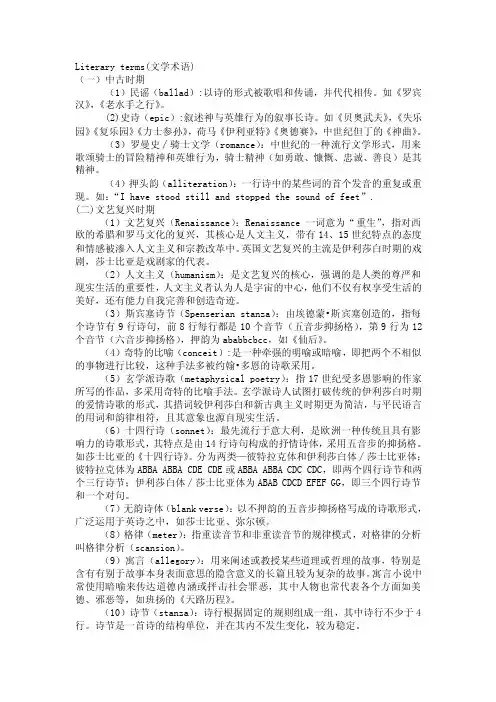
Literary terms(文学术语)(一)中古时期(1)民谣(ballad):以诗的形式被歌唱和传诵,并代代相传。
如《罗宾汉》,《老水手之行》。
(2)史诗(epic):叙述神与英雄行为的叙事长诗。
如《贝奥武夫》,《失乐园》《复乐园》《力士参孙》,荷马《伊利亚特》《奥德赛》,中世纪但丁的《神曲》。
(3)罗曼史∕骑士文学(romance):中世纪的一种流行文学形式,用来歌颂骑士的冒险精神和英雄行为,骑士精神(如勇敢、慷慨、忠诚、善良)是其精神。
(4)押头韵(alliteration):一行诗中的某些词的首个发音的重复或重现。
如:“I have stood still and stopped the sound of feet”.(二)文艺复兴时期(1)文艺复兴(Renaissance):Renaissance一词意为“重生”,指对西欧的希腊和罗马文化的复兴,其核心是人文主义,带有14、15世纪特点的态度和情感被渗入人文主义和宗教改革中。
英国文艺复兴的主流是伊利莎白时期的戏剧,莎士比亚是戏剧家的代表。
(2)人文主义(humanism):是文艺复兴的核心,强调的是人类的尊严和现实生活的重要性,人文主义者认为人是宇宙的中心,他们不仅有权享受生活的美好,还有能力自我完善和创造奇迹。
(3)斯宾塞诗节(Spenserian stanza):由埃德蒙•斯宾塞创造的,指每个诗节有9行诗句,前8行每行都是10个音节(五音步抑扬格),第9行为12个音节(六音步抑扬格),押韵为ababbcbcc,如《仙后》。
(4)奇特的比喻(conceit):是一种牵强的明喻或暗喻,即把两个不相似的事物进行比较,这种手法多被约翰•多恩的诗歌采用。
(5)玄学派诗歌(metaphysical poetry):指17世纪受多恩影响的作家所写的作品,多采用奇特的比喻手法。
玄学派诗人试图打破传统的伊利莎白时期的爱情诗歌的形式,其措词较伊利莎白和新古典主义时期更为简洁,与平民语言的用词和韵律相符,且其意象也源自现实生活。
⽂学知识Key Points for British Literature英国⽂学第⼀节中古时期Old and Medieval English literature(15世纪以前)The Norman Conquest in 1066 marked the beginning of Medieval English literature, which ended around the end of the 15th centuryLanguage spoken by the Anglo-Saxons is called the Old English古时期《贝奥武甫》Beowulf :1)the highest achievement of the old English2)Is a typical example of old English poety and is the oldest surviving alliterative epic(头韵诗)卡德蒙Caedom:1)The earliest English poet2)《卡德蒙赞美诗》Caedom's Hymn中时期《⾼⽂爵⼠和绿⾐骑⼠》Sir Gawain and the Green Knight1)One of the best Middle English romance托马斯.马洛礼Thomas Marlory1)《亚瑟王之死》Le Morte D'Arthur威廉.朗格兰William Langland1)《耕者⽪尔斯》Piers the Plowman: 是⼀部长达7000多⾏的头韵长诗(alliterativeepic)2)The early great works of English literature along with Chaucer's The Canterbury Tales杰弗⾥.乔叟Geoffrey Chaucer1)英国诗歌之⽗,英国⼩说之⽗2)《坎特伯雷故事集》The Canterbury Tales3)《坎特伯雷故事集》展现了14世纪的社会全景4)heroic couplet15世纪的作品1)《罗宾汉民谣》The Robin Hood ballads第⼆节⽂艺复兴时期The English Renaissance Period(14世纪到17世纪中期)诗歌The English Renaissance encouraged the reformation of the ChurchA great speed in Elizabethan托马斯.怀亚特Thomas Wyatt1)the most interesting poet of the first half of 16th century and the first to introduce the sonnet into English Literature亨利.霍华德Henry Howard1)英国⽂学史上第⼀个创作⽆韵诗的诗⼈菲利普.锡德尼爵⼠Sir Philip Sidney1)《爱星者与星星》Astrophel and Stella2)《为诗⼀辩》Apology and Poetry埃德蒙. 斯宾塞Edmund Spenser1)诗⼈中的诗⼈the poets poet2)桂冠诗⼈poet laureate3)斯宾塞是伊莉莎⽩时期最伟⼤的⾮戏剧诗⼈,被称为诗圣4)《牧⽺⼈⽇记》The Shepherd's Calendar5)《新婚喜歌》Epithalamion6)《仙后》Faerie Queene:斯宾塞诗体,亚历⼭⼤格式散⽂托马斯.莫尔Thomas More1)《乌托邦》Utopia弗朗西斯.培根Francis Bacon1)第⼀位英国散⽂家2)《亨利七世的统治和⽣活史》3)《论学术的进展》The Advancement of Learing4)《论说⽂集》Eassys5)《新亚特兰蒂斯》The New Atlantis约翰.黎⾥John Lyly1) 《尤弗西斯》Euphues:euphuism(跨市⽂体)戏剧克⾥斯托弗.马洛Christopher Malowe1)莎⼠⽐亚前最伟⼤的剧作家,是⼤学才⼦派(University Wits)中最有天赋的作家,⾸创戏剧的创作⼿法“⽆韵诗”2)《帖⽊⼉》Tamburlaine3)《浮⼠的博⼠的悲剧》4)《马⽿他岛的犹太⼈》The Jew of Malta莎⼠⽐亚1)英国⽂艺复兴时期最重要的剧作家2)喜剧:A Midsummer Night’s Dream; The Merchant of V enice; As You Like It; The Twelfth Night《⼗⼆夜》,Much Alo About Nothing《⽆事⽣⾮》3)悲剧: Hamlet; Othello; King Lear; Macbeth《罗密欧与朱丽叶》4)历史剧:《亨利四世》《亨利五世》5)长诗:《维纳斯和阿多尼斯》Venus and Adonis《露易丝受辱记》The Rape of Lucrece本. 琼森Ben Johnson1)《狐狸》V olpone2)The most important dramatist successors of Shakespeare第三节资产阶级⾰命和王政复辟时期The Period of Revolution and Restoration (17 世纪)资产阶级时期的诗⼈约翰.弥尔顿John Milton1)⽆韵诗⼤师2)他在这⼀时期的地位相当于莎⼠⽐亚在伊莉莎⽩时期,乔叟在中世纪时期的地位3)《失乐园》Paradise Lost : 本书是⾃《贝奥武甫》以后最伟⼤的英国史诗4)《复乐园》Paradise Regained5)《⼒⼠参孙》Samson Agonistes: the most perfect example of the verse drama after the Greek style in English 约翰.多恩John Donne1)⽞学派的创始⼈the founder of the Metaphysical School2)《⽇出》The Sun Rising3)《歌谣与⼗四⾏诗》Songs and Sonnets4)《神圣⼗四⾏诗》Holy Sonnets5)《给圣⽗的赞美诗》A Hymn to God the Father6)《死神莫骄妄》Death, Be Not Proud7)《分别:莫忧伤》A Valediction: Forbidding Mourning乔治.赫伯特George Herbert1)⽞学派的圣⼈the saint of the Metaphysical School2)《祭坛》The Altar: 在这部作品中,作者⽤排版的技巧来表达他对宗教的虔诚3)《复活节的翅膀》Easter Wings资产阶级⾰命时期的散⽂家约翰.班扬1)清教徒清教徒时期地位最⾼的散⽂家,散⽂风格模仿《圣经》2)《天路历程》The Pilgrim's Progress:the most successful religious allegory(寓⾔)3)《落在愤怒之神⼿中的罪⼈》Grace Abounding to the Chief of Sinners4)《贝德曼先⽣》The Life and Death of Mr.Badman5)《圣战》The Holy War王政复辟时期的作家杰⾥⽶.柯⾥尔Jeremy Collier1)a non-conformist clergyman(⾮国传教⼠)2)《略论英国舞台上的不道德和亵渎》A Short View of the Immorality and Profaneness of the English Stage约翰.德莱顿John Dryden1)王朝复辟时期最著名的作家2)18世纪英国古典主义的先驱者the forerunner of the English classical school of literature3)是弥尔顿时期与蒲柏时期之间最伟⼤的诗⼈,称桂冠诗⼈达20年4)他把英雄双韵体作为讽刺诗和描述性诗体的风尚5)英国批评⽂学之⽗the father of English criticism6)《?⿅与豹》The Hind and the Panther7)《⼀切为了爱情》All for Love8)《押沙龙与阿托奈托菲尔》Absalom and Achitophel: subject is politics and is written in heroic couplet9)《论戏剧诗歌》An Essay of Dramatic Poesy: his best work第四节启蒙运动The Age of Enlightenment(18世纪)The 18th century of England is known as the Age of Enlightenment or the Age of Reason(理性时期)Neo-Classicism(新古典主义) made a rapid growth in the 18th centuryThe rise and growth of the realistic novel is the most important achievement in the 18th century English literayure新古典主义作家亚历⼭⼤.浦柏Alexander Pope1) 浦柏是英国18世纪最伟⼤的诗⼈,以讽刺诗体以及对《荷马史诗》的翻译⽽闻名2)⾸次把理性主义带到英国3)《论批评》An Essay on Criticism4) 《夺发记》The Rape of the Lock: 优秀的讽刺史诗a finest mockepic5) 《⼈伦》Essay on Man: a philosophical poem in heroic couplets理查德.斯梯尔Richard Steele 约瑟夫.艾迪⽣Joseph Addison《闲谈者报》和《旁观者报》The Tattler and The Spectator are the literary periodicals by Richard Steele and Joseph Addison塞缪尔.约翰逊Samuel Johnson1)《英语字典》:become the foundation of all the subsequent English dictionaries 2)《诗⼈转》The Lives of English Poet 现实主义作家丹尼尔.笛福Daniel Defoe1)是现代⼩说的奠基⼈2)英国和欧洲⼩说之⽗3)《鲁宾逊漂流记》Robinson Crusoe: the first English novel4)《⾟格顿船长》Captain Singleton:narrator of his own story5)《杰克上校》Colonel Singleton6)《摩尔?弗兰德斯》Moll Flanders: autobiography乔纳森.斯威夫特1)An Irish master of Satires2)《⼀个⽊桶的故事》A Tale of a Tub: a parable(寓⾔),established his name as a satirist3)《⼀个⿇布商的书信》The Drapper's Letters4)《⼀个谦卑的建议》A Modest Proposal: the author denounces the cruel and unjust treatment of Ireland by the English government and stir up the Irish people to fight5)《对1708的预⾔》Predictions for the Year 17086)《⽐克斯塔夫先⽣第⼀个预⾔的应验》Vindication of Isaac Bickerstaff7)《格列弗游记》Gulliver’s Travels:本书是对英国和欧洲⽣活各个⽅⾯最有效的,最具破坏性的批评和讽刺亨利.菲尔丁Henry Fielding1)Father of the English NovelAs a novelist:2)《约瑟夫.安德鲁斯的经历》:in the preface, he decribes the novel" a comic epic poem in prose''(散⽂滑稽史诗)3)《⼤伟⼈乔纳森.魏尔德》Jonathan Wild the Great: exposes the English bourgeois society(资产阶级社会)and mocks at its political system4)《弃婴汤姆.琼斯的故事》The History of Tom Jones, a Foyndling:以⼈性为主题,作者认为⼈性是善与恶的结合5)《阿⽶丽亚》Amelia: reveal the shameless deed of the noble and the rich感伤主义作家Writers of Sentimental Tradition塞缪尔.查理森Samuel Richardson1)《帕⽶拉》Pamela, or Virtue Rewarded2)《克拉丽萨》Clarissa Harlowe3)《查尔斯.格兰迪森爵⼠》Sir Richard Grandison劳伦斯.斯特恩Laurence Sterne1)《项狄传》Tristram Shandy2)《伤感旅⾏》A Sentimental Journey奥利弗.⼽德史密斯Oliver Goldsmith1)他是感伤主义学派的杰出代表2)《旅游⼈》The Traveler3)《荒村》The Deserted Village: his best poem4)《威克菲尔德牧师》The Vicar of Wakefield: provide one of the most enduringcharacters in English fiction托马斯.格雷Thomas Gray1)他是感伤主义诗歌,墓畔派的领导⼈。
British Literature英国文学名词解释,背诵第一章:Old and Medieval British Literature(中古时期英国文学)Alliteration (头韵): It is the repetition of the initial consonant sounds in poetry. In 0ld English alliterative meter, alliteration is the principal organizing device of the verse line, such as in Beowulf.Ваllаd (民谣): It is a relatively short narrative poem, written to be sung, with a simple and dramatic action. The ballads tell of love, death, the supernatural, or a combination of these. Two characteristics of the ballad are incremental repetition and the ballad stanza. Incremental repetition repeats one or more lines with small but significant variations that advance the action. The ballad stanza has four lines; commonly, the first and third lines contain four feet or accents, the second and fourth lines contain three feet. Ballads often open abruptly, present brief description and use concise dialogue.Old English period (the Anglo-Saxon period): 1) The Old English period, extended from the invasion of Celtic England by Germanic tribes (the Angles, Saxons, and Jutes) in the first half of the fifth century to the conquest of England in 1066 by the Norman French under the leadership of William the Conqueror. 2)Only after they had been converted to Christianity in the seventh century did the Anglo-Saxons, whose earlier literature had been oral, begin to develop a written literature.Consonance (假韵): It refers to the repetition of similar consonant sounds in a group of words. Sometimes the term refers to the repetition of consonant sounds in the middle or at the end of words. Sometimes the term is used for slant rhyme (or partial rhyme)in which initial and final consonants are the same but the vowels different: litter/ letter , green/groan.Couplet (两行诗): It refers to the two consecutive lines of poetry that rhyme. A heroic couplet is an iambic r pentameter couplet.Epic (史诗): Epic, in poetry, refers to a long work dealing with the actions of gods and heroes,Imagery (意象) : Words or phrases that create pictures or images in the readers‘mind. Images can appeal to other senses as well: touch, taste, smell and hearing.Kenning (隐喻表达法): In old English poetry, an elaborate phrase that descries persons, thing or events in a metaphorical and indirect way.Legend (传奇): A song or narrative handed down from the past. Legend differs from myths on the basis of the elements of historical truth they contain.Ottava Rima ( 八行体): A form of eight-line stanza, the rhyme scheme is abababcc.Romance (罗曼史/骑士文学): Any imagination literature that is set in an idealized world and deals with heroic adventures and battles between good characters and villains or monsters. Originally, the term referred to a medieval tale dealing with the loves and adventures of kings, queens, knights and ladies, and including unlikely or supernatural happenings. Sir Gawain and the Green Knight (高文爵士与绿衣骑士) is the best of medieval romances. John Keats‘The Eve of St. Agnes (圣爱格尼斯节前夕) is one of the greatest metrical romances ever written.Simile (明喻): A comparison made between two things through the use of a specific word of comparison, such as like, as, than or resemble, and the comparison must be between two essentially unlike things.Understatement (含蓄): It is a figure of speech in literature writing. It deliberately represents something as very much less in magnitude or importance than it really is, or is ordinarily considered to be. The effect usually is ironic.Middle English period: The four and a half centuries between the Norman Conquest in 1066, which effected radical changes in the language, life, and culture of England, and about 1500, when the standard literary language had become recognizably modern English, that is, similar to the language we speak and write today.Arthurian legend: It is a group of tales (in several languages) that developed in the Middle Ages concerning Arthur, semi-historical king of the Britons and his knights. The legend is a complex weaving of ancient Celtic mythology with later traditions around a core of possible historical authenticity.第二章:British Literature of the Renaissance Period (文艺复兴时期英国文学)Allegory (寓言): A tale in verse or prose in which characters, actions, or settings represent abstract ideas or moral qualities. An allegory is a story with two meanings: a literal meaning and a symbolic meaning.Aphorism (格言): A concise, pointed statement expressing a wise or clever observation about life.Blank verse (无韵体诗): Verse written in unrhymed iambic pentameter. It is the verse form used in some of the greatest English poetries, including that of William Shakespeare and John Milton.Comedy (喜剧): In general, a literary work that ends happily with a healthy ,amicable armistice between the protagonist and society.Essay (散文): A piece of prose writing, usually short, that deals with a subject in a limited way and expresses a particular point of view. An essay may be serious or humorous, tightly organized or rambling, restrained or emotional. The two general classifications of essay are: the informal essay and the formal essay. An informal essay is usually brief and is written as if the writer is talking informally to the readers about some topic, using a conversational style and a personal or humorous tune. By contrast, a formal essay is tightly organized, dignified in style and serious in tone.Foreshadowing (预兆): The use of hints or clues in a narrative lo suggest what will happen later. Writers use foreshadowing to create interest and to build suspense. Sometimes foreshadowing also prepares the reader for the ending of the story.Humanism ( 人文主义): Humanism is the essence of the Renaissance. It emphasizes the dignity of human beings and the importance of the present life. Humanists voiced their beliefs that man was the center of the universe and man did not only have the right to enjoy the beauty of the present life , but had the ability to perfect himself and to perform wonders.Paradox(似非而是): A statement or expression so surprisingly self-contradictory as to provoke us into seeking another sense or context in which it would be true.Morality Play (道德剧) : An outgrowth of Miracle Plays. Morality Play was popular in the 15th and 16th centuries. In it, virtues and vices were personified.Meter (格律) : A generally regular pattern of stressed and unstressed syllables in poetry. The analysis of the meter is called scansion.Miracle Play (奇迹剧) : A popular religious drama of medieval England. Miracle Plays were based on stories of the saints or sacred history.Narrative poem (叙述诗): A Narrative poem refers w a poem that tells a story. It may consist of a series of incidents, as in Homer's The Iliad and The Odysseus, and John Milton's Paradise Lost.Pastoral (牧歌): A type of poem that deals in an idealized way with shepherds and rustic life. Two pastoral poems are Christopher Marlow's The Passionate Shepherd to His Lover and Sir Walter Raleigh's The Nymph’s Reply to the Shepherd.Ralegh’s poem might be called anti-pastoral because of its realistic tone.Poetry (诗歌): The most distinctive characteristics of poetry are form and music. Poetry is concerned with not only what is said but how it is said. Poetry evokes emotions rather than express facts. Poetry means having a poetic experience. Imagination is also an essential quality of poetry. Poetry often leads us to new perceptions, new feelings and experiences of which we have not previously been aware.Quatrain (四行诗): Usually a stanza or poem of four lines. A quatrain can also be any group of four lines unified by a rhyme scheme. Quatrains usually follow an abab, abba or abcb rhyme scheme.Renaissance (文艺复兴): The term originally indicated a revival of classical (Greek and Roman) arts and sciences after the dark ages of medieval obscurantism. Humanism is the essence of Renaissance. The real mainstream of English Renaissance is the Elizabethan drama with William Shakespeare being the leading dramatist.Soliloquy (独白): In drama, an extended speech delivered by a character alone on stage. The character reveals his or her innermost thoughts and feelings directly to the audience, as if thinking aloud.Sonnet (十四行诗): A fourteen-line lyric poem, usually written in rhymed iambic pentameter.A sonnet generally expresses a single theme or idea.Spenserian Stanza (斯宾塞诗节):A nine-line stanza with the flowing rhyme scheme: ababbcbcc. The first eight lines are written in iambic pentameter. The ninth line is written in iambic hexameter and is called an alexandrine.Stanza (诗节):It’s a structural divi sion of a poem, consisting of a series of verse line which usually comprise a recurring pattern of meter and rhyme.Terza rima (三行体): An Italian verse form consisting of a series of thee-line stanzas in which the middle line of each stanza rhymes with the first and third lines of the following stanza.Tragedy (悲剧): In general, a literary work in which the protagonist meets an unhappy or disastrous end. Unlike comedy, tragedy depicts the actions of a central character who is usually dignified or heroic.Trochee (抑扬格):A metrical foot used in formal poetry. It consists of a stressed syllable followed by an unstressed one.University Wits (大学才子):University Wits refers to a group of scholars during the Elizabethan Age who graduated from cither Oxford or Cambridge. They came to London with the ambition to become professional writers. Some of them later became famous poets and playwrights. They were called" University Wis". Robert Greene, Thomas Kyd, Jhon Lyly and Christopher Marlowe were among them. They paved the way, to some extent, for the coming of Shakespeare.Utopia (乌托邦): It is written in a conversation form between More and Hythloday, a returned voyager. It is divided into two books. The first book contains a long discussion on the social conditions of England. The second book describes in detail an ideal communist society, Utopia.Francis Bacon: Francis Bacon (1561-1626), was an English philosopher, statesman, scientist, lawyer, jurist, author and pioneer of the scientific method. He served both as Attorney General and Lord Chancellor of England. Although his political career ended in disgrace, he remained extremely influential through his works, especially as philosophical advocate and practitioner of the scientific method during the scientific revolution. His essays are famous for its brief and wise quotations and the most widely-read works are his essays “Of Studies”, “Of Truth” and “Of Death”.第三章:The 17th Century -The Period of Revolution and Restoration (17世纪资产阶级革命和王朝复辟时期)Assonance (押韵): The repetition of similar vowel sounds, especially in poetry. Assonance is often employed to please the ear or emphasize certain sounds.Carpe Diem (及时行乐):A tradition dating back to classical Greek and Latin poetry and particularly popular among English Cavalier poets. Carpe Diem means literally “seize the day”, that is, “live for today”.Didactic literature (教诲文学):Didactic literature is said to be didactic if it deliberately teaches some moral lessons. The use of literature for such teaching is one of its traditional justifications.Elegy (挽歌): A poem of mourning, usually over the death of an individual. An elegy is a type of lyric poem, usually formal in language and structure, and solemn or even melancholy in tone.Genre (体裁):A literary species or form, e. g·, tragedy, epic, comedy, novel, essay, biography and lyric poem.Metaphor (暗喻): A figure of speech that makes a comparison between two things that are basically dissimilar. Unlike simile, a metaphor does not use a connective word such as like, as, or resemble in making the comparison.Metaphysical poetry (玄学派诗歌) : The poetry of John Donne and other 17th century poets who wrote in a similar style. Metaphysical poetry is characterized by verbal wit and excess, ingenious structure, irregular meter, colloquial language, elaborate imagery, and a drawing-together of dissimilar ideas.Conceit (奇想): Conceit is a far-fetched simile or metaphor; a literary conceit occurs when the speaker compares two highly dissimilar things. Conceit is extensively employed in John Donne's poetry.Paradise Lost: Paradise Lost is an epic poem in blank verse by the 17th-century English poetJohn Milton:The poem concerns the Christian story of “the Fall of Man”: the temptation of Adam and Eve by the fallen angel Satan and their expulsion from the Garden of Eden. Milton's purpose, stated in Book I, is to " justify the ways of God to men and elucidate the conflict between God's eternal foresight and free will.blank verse: Blank verse is a type of poetry, distinguished by having a regular meter, but no rhyme. In English, the meter most commonly used with blank verse has been iambic pentameter (as used in Shakespearean plays). The first known use of blank verse in the English language was by Henry Howard, Earl of Surrey. Christopher Marlowe was the first English author to make full use of the potential of blank verse, and also established it as the dominant verse form for English drama in the age of Elizabeth I and James I. The major achievements in English blank verse were made by William Shakespeare, who wrote much of the content of his plays in unrhymed iambic pentameter, and Milton, whose Paradise Lost was written in blank verse.第四章: The 18th Century- -The Age of Enlightenment in England (18世纪英国启蒙运动阶段)Aside (旁白): In drama, line spoken by a character in an undertone or directly to the audience. An aside is meant to be heard by the other characters onstage.Classicism (古典主义运动): A movement or tendency in art, literature, or music that reflects the principles manifested in the art of ancient Greece and Rome. Classicism emphasizes the traditional and the universal, and the places value on reason, clarity, balance, and order. Classicism, with its once for reason and universal themes, is traditionally opposed to Romanticism, which is concerned with emotions and personal themes.Enlightenment Movement (启蒙运动):Enlightenment is an intellectual movement that originates in Europe and comes to America in the 18th century. It stresses the power of human reason, the importance of methods and discoveries instead of God. Its purpose is to enlighten the whole world with the light of modern philosophical and artistic ideas. It celebrates reason or rationality, equality and science. It advocates universal education.Denouement (结局): The outcome of a plot. The denouement is that part of a play, short story, novel, or narrative poem in which conflicts are resolved or unraveled, and mysteries and secrets connected with the plot are explained.Epistolary novel (书信体小说): An epistolary novel is a novel told through the medium of letters written by one or more of the characters. The usual form is the letter, but diary entries, newspaper clipping and other documents are sometimes used. The epistolary novel's reliance on subjective points of view makes it the forerunner of the modern psychological novel.Farce (闹剧):A type of comedy based on a ridiculous situation, often with stereotyped characters. The humor in a farce is largely slapstick--that is, it often involves crude physical action. The characters in a farce are often the butts of practical jokes.Fiction (小说) : Prose narrative based on imagination, usually a novel or a short story.Gothic Romance (哥特小说): A type of novel that flourished in the lat-18th and early-19th century in England. Gothic romances are mysteries, often involving the supernatural and heavily tinged with horror, and they are usually against dark backgrounds of medieval ruins and haunted castles.The Graveyard School (墓地派诗歌): The Graveyard School refers to a school of poets of the 18th century whose poems are mostly devoted to a sentimental lamentations or meditation on life, past and present, with death and graveyard as themes. Thomas Gray is considered to be the leading figure of this school and his Elegy Witten in a Country Churchyard is his most representative work.Mock epic (讽刺史诗): A comic literary form that treats a trivial subject in the grand, heroic style of the epic. A mock epic is also referred to as a mock heroic poem.Neoclassicism (新古典主义): A revival in the 17th and 18th centuries of classical standards of order, balance, and harmony in literature. John Dryden and Alexander Pope were major exponents of the neoclassical school.Novel (小说): A book-length fictional prose narrative, having many characters and often a complex plot.Pre-romanticism (前浪漫主义): It originated among the conservative groups of men and letters as a reaction against Enlightenment and found its most manifest expression in the "Gothic Novel”. The term arose from t he fact that the greater part of such romances were devoted to the medieval times.Refrain (叠句): A word phrase, line or group of lines repeated regularly in a poem, usually at the end of each stanza. Refrains are often used in ballads and narrative poems to create a songlike rhythm and to help build suspense. Refrains can also serve to emphasize a particular idea.Satire (讽刺): A kind of writing that holds up to ridicule or contempt the weaknesses and wrong doings of individuals, groups, intuitions, or humanity in general. The aim of satirists is to set a moral standard for society, and they attempt to persuade the readers to see their points of view through the force of laughter.Sentimentalism (感伤主义): Sentimentalism came into being as a result of a bitter discontent on the part of certain enlighteners in social reality. It is a pejorative term to describe false orsuperficial emotion, assumed feeling, self-regarding postures of grief and pain. In literature, it denotes " pathetic indulgence”.Theme (主题): The general idea or insight about life that a writer wishes to express in a literary work. All the elements of a literary work- plot, setting, characterization, and figurative language---contribute to the development of its theme.English Enlightenment: With the advent of the 18th century in England, there sprang into life a progressive intellectual movement known as the Enlightenment or the Age of Reason. The enlighteners held the common faith in human rationality, eternal justice and natural equality. The great enlighteners in Britain were those great writers like Alexander Pope, Joseph Addison, Jonathan Swift and Samuel Johnson.British neoclassicism: In English literature, the stylistic trend between the Restoration and the advent of romanticism at the beginning of the 19th century is referred to as neoclassicism. The term " neoclassicism” is derived from the convictions of the leading poet-critics of the age that literary theory and practice should follow the models established by Greek and Latin writers. These critics held that writers should emphasize types rather than individual characteristics; adhere to " nature " by aspiring to order and regularity; and strictly observe the unities of time, place, and action in dramatic composition. Major British neoclassicists are John Dryden, Alexander Pope and Samuel Johnson."A Modest Proposal":"A Modest Proposal" is a famous satire written by Jonathan Swift. Assuming the cool tone of an impartial outsider, the author suggests that children of the poor Irish people be sold at one year old as food for the English nobles, Written with much conciseness and terseness, the " proposal" is by far the most consummate artistic expression of Swift’s indignation toward the terrible oppression and exploitation of the Irish people by the English ruling class.Picaresque novel: 1) Derived from the Spanish word picara, meaning " rogue" or " rascal”, the term generally refers to a basically realistic and often satiric work of fiction chronicling the career of an engaging, lower-class rogue-hero, who takes to the road for a series of loose, episodic adventures, sometimes in the company of a sidekick. 2) Well-known examples of the picaresque novel are Cervantes Don Quixote (1605) and Henry Fielding's Tom Jones (1749).第五章The Age of Romanticism (浪漫主义时期的英国文学)Byronic hero (拜伦式的英雄) :Byronic hero refers to a proud, mysterious rebel figure of noble origin. With immense superiority in his passions and powers, he would carry on his shoulders the burden of righting all the wrongs in a corrupt society, and would rise single-handedly against any kind of tyrannical rules either in government, in religion, or in moral principles with unconquerable wills and inexhaustible energies.Canto (篇/章): A section or division of a long poem. In English poetry , Alexander Pope's The Rape of the Lock (《夺发记》)and Byron's Don Juan (《唐璜》) are divided into cantos.Fable (寓言): A fable is a short story, often with animals as its characters. It illustrates a moral.Lake Poets (湖畔派诗人); Romantic poets such poets as Willian Wordsworth, Samuel Taylor Coleridge and Robert Southey who lived in the Lake District came to be known as the Lake School or Lake poets.Lyric (抒情诗): Lyric is a poem, usually a short one, which expresses a speaker’s personal thought and feelings. The elegy, ode, and Bonnet are all forms of the lyric.Ode (颂歌) : Usually a lyric poem of moderate length, with a serious subject, an elevated style, and an elaborate stanza pattern. The ode often praises people, the arts of music and poetry, natural scenes, or abstract concepts, The Romantic poets used the ode to explore either personal or general problems; they often started with a meditation on something in nature ,as Keats' Ode to a Nightingale or Shelley's Ode to the West Wind.Romanticism (浪漫主义): A movement that flourished in literature, philosophy, music, and art in Western culture during most of the 19th century, beginning as a revolt against classicism. Romanticism gave primary concern to passion, emotion, and natural beauty. The English Romantic period is an age of poetry.tercet: Tercet refers to a unit of three verse lines, usually rhyming either with each other or with neighboring lines and three-line stanzas of terza rima and of the villanelle are known as tercets.Charles Lamb: Charles Lamb (1775- -1834) was an English essayist, best known for his Essays of Elia and children's book Tales from Shakespeare, which he produced with his sister, Mary Lamb. Lamb has been referred to as the most lovable figure in English literature, and his influence on the English essay form surely cannot be overestimated.第六章The Victorian Period- English Critical Realism (维多利亚时期英国批判现实主义文学)Allusion (暗指/典故): A reference to a person, a pace, an event or a literary work that a writer expects the readers to recognize and respond to. An allusion may be drawn from history, geography, literature or religion.Antagonist (反面人物): A person or force opposing the protagonist in a narrative; a rival of the hero or heroine.Character (角色):In appreciating a short story, characters are indispensable elements. Characters are the persons presented in a dramatic or narrative work. Forst divides characters into two types: flat character, which is presented without much individualizing detail; and round character, which is complex in temperament and motivation and is represented with subtle particularity.Critical Realism (批判现实主义): The Critical Realism of the I9h century flourished in the 1840s and in the beginning of the 1850s. The realists first and foremost set themselves the task of criticizing capitalist society from a democratic viewpoint and delineated the crying contradictions of bourgeois reality. But they did not find way to eradicate social evils. Charles Dickens is the most important critical realist.Dramatic Monologue (戏剧独白): A kind of narrative poem in which one character speaks to one or more listeners whose replies are not given in the poem. The occasion is usually a crucial one in the speaker's personality as well as the incident that is the subject of the poem. Robert Browning's My Last Duchess is a typical example.Flashback (倒叙): A scene in a short story, novel, play or narrative poem that interrupts the action to show an event that happened earlier.Narration (叙述) : Like description, narration is a part of conversation and writing. Narration is the major technique used in expository writing, such as autobiography Successful narration must grow out of good observation, to-the-point selection from observation and clear arrangement of details in logical sequence, which is usually chronological. Narration gives an exact picture of things as they occur.Narrator (陈述者) : One who narrates or tells a story. A story may be told by a first-person narrator, someone who is either a major or minor character in the story. Or a story may be told by a third-person narrator, someone who is not in the story at all. Narrator can also refer to a character in a drama who guides the audience through the play, often commenting on the action and sometimes participating in it.Psychological Novel (心里小说):It refers to a kind of novels that dwell on a complex psychological development and present much of the narration through the inner workings of a character's mind. Thackeray's characterization of Rebecca Sharp is very much psychological.Point of view (叙述角度): The perspective from which the story is told. The most obvious point of view is probably the first person or "I". The omniscient narrator knows everything, may reveal the motivations, thoughts and feelings of the characters, and gives the reader information. With a limited omniscient narrator, the material is presented from the point of view of a character, in the third person. The objective point of view presents the action and the characters' speech, without comment or emotion. The reader has to interpret them and uncover their meanings. A narrator may be trustworthy or untrustworthy, involved or uninvolved.Plot (情节): Plot is the first and most obvious quality of a story. It is the sequence of events or actions in a short story, novel, play or narrative poem. For the readers, the plot is the underlying patter in a work of fiction, the structural element that gives it unity and order. For the writer, the plot is the guiding principle of selection and arrangement. Conflict, a struggle of some kind, is the most important element of plot.Protagonist (正面人物): It refers to the hero or central character who is often hindered by some opposing force either human or animal in accomplishing his or her objectives.Bildungsroman (成长小说): Bildungsroman defines a genre of the novel which focuses on the psychological and moral growth of the protagonist from youth to adulthood, and in which characters' change is thus extremely important. In a Bildungsroman, the goal is maturity. Charles Dickens' David Copperfield is a classic Bildungsroman.Victorian period: 1) Chronologically the Victorian period roughly coincides with the reign of Queen Victoria who ruled over England from 1836 to 1901. The period has been generally regarded as one of the most glorious in the English history. 2) In this period, class struggle was very tense. As a result, a new literary trend- critical realism appeared. The criticism of the 19th century flourished in the forties and in the early fifties. The critical realists described with much vividness and great artistic skill the chief traits of the English society and criticized the capitalist system from a democratic view point. In this period, the novel became the most widely read and the most vital and challenging expression of progressive thought. The Victorian age also produced a host of great prose writers. The poetry of this period was mainly characterized by experiments with new styles and new ways of expression. 3) Victorian literature as a product of its age, naturally took on its quality of magnitude and diversity. It was many-sided and complex, and reflected both romantically and realistically the great changes that were going on in people's life and thought.第七章:The 20th Century British Literature (20世纪英国文学)Aestheticism or the Aesthetic Movement (唯美主义): It began to prevail in Europe in the middle of the 19th century. The theory of " art for art's sake" was first put forward by the French poet Theophile Gautier. They declared that art should serve no religious, moral or social purpose. The two most important representatives of aestheticists in English literature are Walt Pater and Oscar Wilde.Black comedy or Black humor (黑色幽默): It is mostly employed to describe baleful, naive, or inept characters in a fantastic or nightmarish modern world playing out their roles in what Ionesco call a" tragic fare”, in which the events are often simultaneously comic, horrifying, and absurd. Joseph Heller’s Catch-22 can be taken as an example of the employment of this technique.。
英国文学Part 1. Old and medieval 【中古时期】 Beowulf 贝尔武甫(the national epic of theEnglish people) stricking feature:alliteration, metaphors andunderstatements.The Robin Hood Ballads 罗宾汉民谣集 Geoffrey Chaucer 杰佛利·乔叟1340-1400 The father ofEnglish poetry 长诗:The House of Fame 声誉之堂;Troilus and Criseyde 特罗勒斯与克丽西德;The Parliment of Fowls 百鸟会议;The Romaunt of Rose 玫瑰骑士;The Legend of Good Woman贤妇传说小说:Canterbury Tales 坎特伯雷故事集----英国文学史上现实主义第一部杰作his contribution to English poetry:introduced from France the rhymed coupletof 5 accents in iambic meter (the heroiccouplet), is the first great poet who wrotein the English language. Who making thedialect of London the standard for themodern English speech.William Langland Pier the Plowman 农夫皮尔斯Part 2. The English Renaissance 16C a period of the breaking up of feudal relations and the establishing of the foundations of capitalism1.Hundred Years’ War(1337-1453)2.War of Roses(House of Lancaster/York): the Tudor Dynasty都铎王朝3.the Religious Reformation 宗教改革:the Church of England4.the Enclosure Movement 圈地运动5.the Commercial Expansion 商业扩张:Queen Elizabeth6.the War with Spain 西班牙战争:Thomas More托马斯。
中古时期与维多利亚时期英国绅士文化的对比分析作者:冯欢欢来源:《赢未来》2018年第03期摘要:绅士文化是英国文化的精髓。
它以贵族精神为基础,掺杂了各阶层的价值观融合而成,主要来自于贵族精神和中间阶层的文化价值观念。
本文以中古时期和维多利利亚女王时期的绅士文化为研究对象,对绅士文化的特征进行对比分析,从中总结出绅士文化变化发展的规律及文化价值。
对比研究表明,绅士文化的变化与发展与英国阶级的属性及社会的发展密切相关,至今它仍然深刻影响着英国社会的发展进程,而绅士文化的利弊对其他国家文化的传承与发展起到很大的借鉴作用。
关键词:绅士文化;特征;中古时期;维多利亚时期;对比分析一、绅士文化的起源及文化内涵绅士是指举止优雅、待人谦和、谈吐得当的男士,它主要来源于英国绅士。
它还有另一个过时的意思,那就是,来自上流社会阶层的人。
英国绅士文化是英国民族文化的体现,绅士文化经历了传统贵族文化和维多利亚绅士文化两个阶段。
英国绅士文化的起源于中世纪。
维多利亚时期是绅士文化的繁荣时期和最终形成时期。
两次世界大战后,英国绅士文化在英国的发展过程中表现出许多弊端,然后逐渐减弱直至现在消失,但它的许多道德标准和核心价值观仍然影响着现代人。
随着绅士文化的发展和变化,绅士文化被赋予了现代价值。
绅士是英国文化的精髓,是英国人在日常生活中接受标准的价值取向。
了解绅士文化有助于我们更多地了解英国文化和人民,同时,许多外国国家也可以借鉴绅士文化的优秀价值观。
二、中世纪英国绅士文化的特点“绅士”来源于一个古老的法语单词。
它指那些生来就有古老血统的人,实质上是建立在贵族血统和出身的基础上。
英国绅士文化的起源应该追溯到中世纪时期,大约在十四世纪。
这一时期绅士文化的特点是骑士精神、自立精神、礼仪修养。
贵族文化是绅士文化的雏形,同时,最初的绅士文化也是贵族文化的体现。
三.维多利亚时期英国绅士文化的特点维多利亚时期是从1837年到1901年,这是英国的繁荣时期。
英国历史大事年表英国历史(前55~ )1 罗马人占领时期:公元前55年~公元410年2 盎格鲁-撒克逊时期与丹麦统治时期:公元449年~1066年3 诺曼底王朝1066~11544 金雀花王朝1154~13995 兰卡斯特王朝1399~14616 约克王朝1461~14857 都铎王朝1485~16038 斯图亚特王朝1603~17149 汉诺威王朝1714~191710 温莎王朝1917~1、公元前公元前2000-1500年,古印欧人的一支——凯尔特人(罗马人称其为高卢人)西进。
公元前1200-1000年,日耳曼人迫使凯尔特人继续西进到了不列颠岛。
在他们之前在岛上居住的是皮克特人,皮克特人的首都是斯康宫,被苏格兰人称作历史中心,该宫殿以“斯康石”闻名苏格兰,史称“定命石”,因为继承苏格兰王位的每一位王公贵族都要到这里来举行加冕仪式。
直至1296年,英格兰国王爱德华一世决定把这种仪式改在伦敦威斯敏斯特大教堂内举行。
直到诺曼征服后,苏格兰仍有皮克特王国。
史前英国(凯尔特英国,史前—43年)罗马人占领时期:公元前55年~公元410年公元前55年与54年:朱利叶斯·凯撒首次率军入侵不列颠公元43年,罗马皇帝克劳迪厄斯率军征服不列颠【罗马人在不列颠岛设置了行省,不列颠岛被分为军事区(西北部山区)与行政区(东南部平原区)两部分。
罗马人实际上只控制了行政区,北部的苏格兰与西部的威尔士仍在凯尔特人的手中,罗马人为了防备他们的反抗不得不修建了“哈德良长城”】2、中古时期英国盎格鲁-萨克逊英国与七国时代(约440年—850年)与丹麦律法施行区时期(850年—1066年)4~5世纪,罗马帝国日渐衰落,逐渐放弃对不列颠的控制,罗马人从407年开始撤兵,至442年全部退走,结束对不列颠400年的统治。
597年:圣·奥古斯丁到达不列颠,使当地人昄依基督教7世纪,开始形成封建制度,许多小国并成七个王国,争雄达200年之久,史称“盎格鲁—撒克逊时代”。